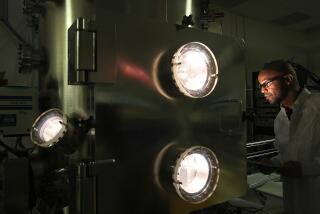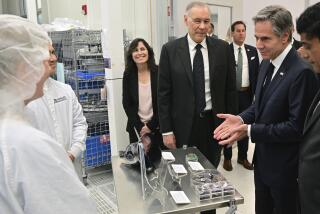Big Computer to Aid in Plans for Fast Plane
- Share via
LA JOLLA — Aerojet General will contribute $1 million to the San Diego Supercomputer Center to finance basic research into a hypersonic airplane that will utilize an experimental propulsion system being developed by Aerojet General, company officials said Friday.
“We’ll be able to promote research in the use of the supercomputer in a mutually beneficial way for both the industrial and academic communities,” said Bob Lee, Aerojet General’s director of information resource systems.
With the $1-million contribution, Aerojet General became the first “industrial associate” to forge a research link with the Supercomputer Center, which was created by the National Science Foundation and is operated by La Jolla-based GA Technologies for a consortium that includes 18 universities and research institutions.
Although 90% of available research time on the supercomputer, which can handle more than 800 million calculations a second, will be used by the 19 universities and research institutions, 10% of the computer’s time will be available to industrial partners that help finance its operations.
Two weeks ago, supercomputer officials indicated that other corporate research arrangements would be forthcoming.
In addition to hypersonic aircraft research, which is being directed by William Heiser at Aerojet General’s Sacramento Propulsion Institute, the company also will use the supercomputer for research into artificial intelligence and development of satellite sensor systems for the Department of Defense’s Strategic Defense Initiative.
N.Y. to Tokyo in 2 1/2 Hours
The hypersonic aircraft which Aerojet has been researching received a boost last month from President Reagan, who described the proposed high-speed aircraft--which would cut flying time between New York and Tokyo to just 2 1/2 hours--as “the new Orient Express.”
The supercomputer will speed basic research because it is both speedy and “on-line interactive,” Lee said. “It’s like letting us solve problems inside a goldfish bowl. We can see (research) as it’s going on, and if we see that we’re building the wrong thing, we can stop it, make an adjustment and start going again.”
The supercomputer, which is housed in a new building on the UC San Diego campus, probably will cut in half the “number crunching” needed to solve difficult problems, said Lee, who added that even more time will be saved “because it is on-line interactive and we’ll be able to monitor the progress we’re making.”
More to Read
Inside the business of entertainment
The Wide Shot brings you news, analysis and insights on everything from streaming wars to production — and what it all means for the future.
You may occasionally receive promotional content from the Los Angeles Times.










